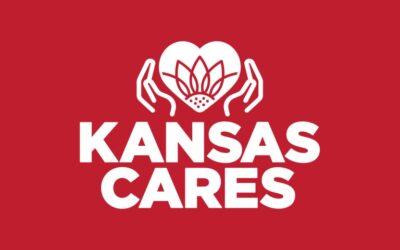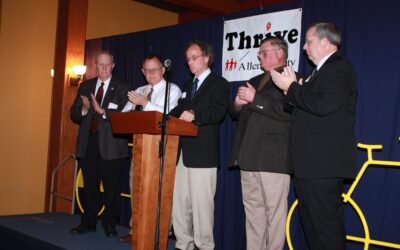When Dr. Brian Wolfe received his COVID vaccine, he was almost disappointed. He experienced no side effects from the shot, other than a slight pain in the arm. As he explained, the mild reactions that some of his colleagues have experienced–muscle soreness, headaches, night sweats and generally “feeling crummy”–are not a cause for concern. In fact, they are a good sign! A mild reaction to a shot shows that your body is processing the vaccine and building up immunity.
Dr. Wolfe, who serves as the chair of the Thrive Board of Directors when not working at Iola’s Community Health Center of Southeast Kansas, received his second COVID vaccine dose last week. His clinic and Allen County’s other healthcare facilities are working to immunize their employees who work with vulnerable patients. For them, the vaccine’s arrival was a moment of relief and optimism. However, our community has a long road ahead to put the pandemic behind us.
Sowing Skepticism
Many rural residents hesitate to get the vaccine, the Kaiser Family Foundation reports:
35% of rural Americans say they either will not or probably will not get it.
People living in rural America are no less likely than people in urban or suburban areas to know someone who has tested positive or died from coronavirus, they have other reasons for their hesitancy.
They are less worried than their urban counterparts that someone in their family will get sick from the virus. And more rural Americans say the pandemic is exaggerated compared to people in the suburbs and the cities.
Strikingly, 62% of rural residents see getting vaccinated as a personal choice compared with 36% who see it as part of their responsibility to protect the health of others in the community. Its just the opposite for people in urban areas.
Dr. Wolfe sees a few reasons behind this apprehension. Some individuals worry about the vaccine’s quick approval. However, he assures that the vaccine has undergone rigorous safety testing. COVID vaccine development sped along by building on the existing vaccine for a closely related virus: Severe Acute Respiratory Syndrome, or SARS. You might remember the outbreak of SARS in 2003. In the nearly two decades since then, scientists have done extensive research on the virus. Armed with this knowledge, when COVID came along, researchers did not have to start from scratch.
Additionally, today’s vaccine technology has reached new heights. By using nanotechnology that helps the immune system build antibodies without introducing the virus itself, researchers created a highly effective and precise vaccine. Dr. Wolfe has complete trust in these researchers and the vaccines that they have produced.
Unfortunately, safety concerns are not the only issue hindering widespread immunization. To Dr. Wolfe’s frustration, some groups categorically refuse the vaccine. “They have the attitude that they can do whatever they want, which is not good for a community,” he explains. Furthermore, a vicious rumor mill has gotten ahead of evidence-based public health information. Dr. Wolfe worries distrust and misinformation may stop our community from achieving widespread immunity.
Reaching a Critical Point
As we enter 2021, and the virus batters our healthcare system for a second year, our community needs this vaccine soon. With widespread refusal to wear masks and social distance, our current management of the disease is simply not enough. Our healthcare system is out of resources, and terrifyingly so. Even barring deadly circumstances, our current lifestyle of caution and quarantine is not sustainable forever. “This pandemic is not going away. To get back to normalcy–if there’s such a thing as normalcy–we need this vaccine,” says Dr. Wolfe.
Specifically, we need to achieve herd immunity through vaccination. The CDC estimates that 75 to 85% of the population needs immunity to cover those who are not protected. Herd immunity prevents exposure for the unvaccinated and the rare few who fall outside the vaccine’s 95% effectiveness rate.
As the vaccine rolls out, the end of this pandemic is in sight. It’s time for Allen County to take the steps to reach it.
The Road Ahead
It’s clear we need widespread vaccinations in our community. But how, when, and where do we get it? The answer can be complicated. The Pfizer and Moderna vaccines in use in Kansas require two doses, each from the same manufacturer, given three to four weeks apart. The Kansas Department of Health and Environment has established five phases of vaccinations.

As a healthcare provider, Dr. Wolfe was vaccinated in Phase One. He expects that Phase Two will begin after February 1. However, everything depends on availability and instructions from public health officials up the chain. For Allen County, the Southeast Kansas Multi-County Health Department plans to host immunization clinics when the vaccine is available. Most people can expect to get their shots in the spring or summer. However, until we better understand the vaccine’s long-term effectiveness, masks and social distancing remain our best defense. Even though Dr. Wolfe has passed the one-week mark since his second vaccine dose, he wears a mask in public for extra protection and to set a good example for the community. Both the Southeast Kansas Multi-County Health Department and Kansas Department of Health and Environment recommend wearing a mask even after receiving the vaccine.
This waiting game might be hard for Allen County. The end of this pandemic is tantalizingly close. But what we do between now and then means everything for our healthcare workers, small businesses, and neighbors. Immunization–waiting our turn for the vaccine and taking it when the time comes–is our last big task to help our community through this crisis.



